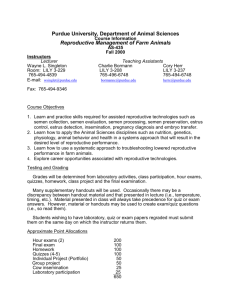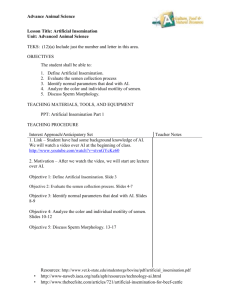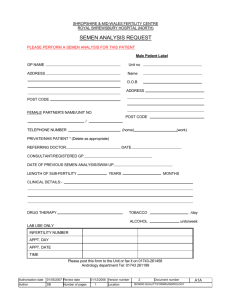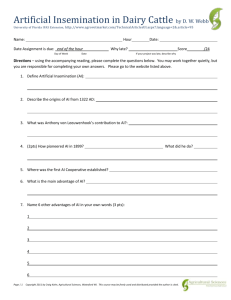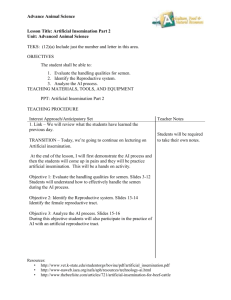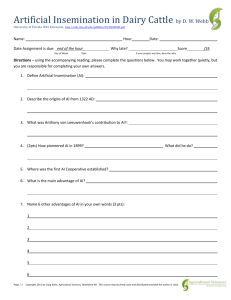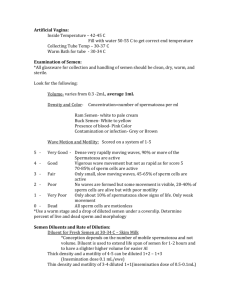bsaa artificial insemination worksheet
advertisement
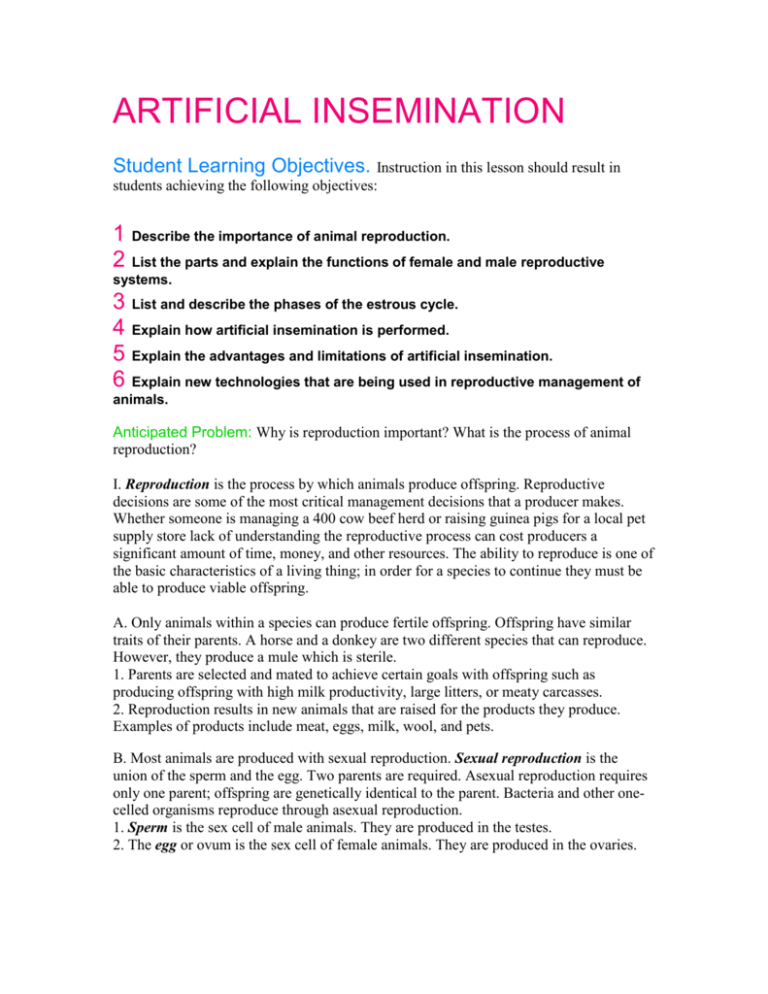
ARTIFICIAL INSEMINATION Student Learning Objectives. Instruction in this lesson should result in students achieving the following objectives: 1 Describe the importance of animal reproduction. 2 List the parts and explain the functions of female and male reproductive systems. 3 List and describe the phases of the estrous cycle. 4 Explain how artificial insemination is performed. 5 Explain the advantages and limitations of artificial insemination. 6 Explain new technologies that are being used in reproductive management of animals. Anticipated Problem: Why is reproduction important? What is the process of animal reproduction? I. Reproduction is the process by which animals produce offspring. Reproductive decisions are some of the most critical management decisions that a producer makes. Whether someone is managing a 400 cow beef herd or raising guinea pigs for a local pet supply store lack of understanding the reproductive process can cost producers a significant amount of time, money, and other resources. The ability to reproduce is one of the basic characteristics of a living thing; in order for a species to continue they must be able to produce viable offspring. A. Only animals within a species can produce fertile offspring. Offspring have similar traits of their parents. A horse and a donkey are two different species that can reproduce. However, they produce a mule which is sterile. 1. Parents are selected and mated to achieve certain goals with offspring such as producing offspring with high milk productivity, large litters, or meaty carcasses. 2. Reproduction results in new animals that are raised for the products they produce. Examples of products include meat, eggs, milk, wool, and pets. Illinois Biological Science Applications in Agriculture Lesson C3–1 • Page 4 B. Most animals are produced with sexual reproduction. Sexual reproduction is the union of the sperm and the egg. Two parents are required. Asexual reproduction requires only one parent; offspring are genetically identical to the parent. Bacteria and other onecelled organisms reproduce through asexual reproduction. 1. Sperm is the sex cell of male animals. They are produced in the testes. 2. The egg or ovum is the sex cell of female animals. They are produced in the ovaries. C. Fertilization is the process by which the union of a sperm and an egg occurs. It is also known as conception. Conception takes place in the female’s reproductive tract for dogs, cattle, hogs, and many other animals. Fertilization occurs outside of the body for organisms such as fish. 1. The process of placing sperm in the reproductive tract of the female is known as insemination. 2. Natural insemination occurs when a male of a species mates with a female of the same species. Sperm are placed in the female reproductive tract by the male during copulation. a. Copulation is the mating process in which sperm are ejaculated from the penis of the male in the vagina of the female. Producers often refer to this as breeding. b. Females must be receptive to males at a time in the estrus cycle known as heat. 3. Artificial insemination (AI) is used in some situations, such as with dairy and beef cows, horses, and others. Artificial insemination involves placing semen collected from a male in the female reproductive tract using equipment designed for the purpose. AI is a key management tool for producers that allows them to have greater choices in selecting beneficial traits for improved genetic performance. D. Once an egg has been fertilized, it becomes an embryo that attaches itself to the uterine wall for nourishment. This state of pregnancy is referred to as gestation. Gestation varies greatly between species and can last form a few weeks to over a year. 1. The embryo goes through a time of development and becomes a fetus. The fetus develops to a stage where it is born and can live outside the uterus. 2. Parturition is the act of giving birth and is the final stage of the reproductive process. Anticipated Problem: What are the major parts of female and male reproductive systems? What are the functions of the parts? II. The reproductive system is the only organ system that varies among males and females of the same species. A. The reproductive system of the female is designed to produce eggs, make conception possible, and promote development of the embryo/fetus until birth. The major parts of the system are: 1. The vulva is the external part of the female reproductive and urinary tracts. Inside the vulva is the clitoris which is the sensory organ of the female. 2. The vagina is the mating organ of the female. It receives semen (sperm cells) from the male and serves as the canal through which the fetus moves during birth. 3. The cervix is the entrance to the uterus. 4. The uterus is the organ in which the embryo and fetus develop. The uterus is Yshaped. It contains the cervix and two uterine horns. Females that usually have only one offspring at a time such as a cow have small uterine horns and a large uterine body. Organisms such as sows that have large litters, have a small uterine body and large uterine horns. 5. The oviduct (also known as the fallopian tube) is a tube leading from the ovaries to the uterus. Fertilization usually takes place near the upper end of the oviduct. After fertilization, the zygote travels to the uterus for implantation. There are two oviducts; one for each ovary. 6. The ovary is the organ that produces the eggs or ova. Eggs pass from the ovary into the oviduct. a. When the egg is releases from the ovary, it is referred to as ovulation. B. The reproductive system of the male is designed to produce and store sperm and to deposit them in the reproductive tract of the female of the species. The major parts are listed below. 1. The penis is the male reproductive organ that deposits semen in the reproductive tract of the female. a. Semen is a fluid containing sperm secreted by the seminal and prostate glands. b. Semen is expelled by a process known as ejaculation. Sexual stimulation during the mating process is needed for ejaculation to occur. c. The retractor muscle and the sigmoid flexure (bulls, boars, and rams) causes the penis to extend and return from the sheath. 2. The urethra is the tube that extends through the penis from the urinary bladder. 3. The seminal glands produce fluids that promote the production of viable sperm. 4. The seminal vesicles are organs attached to the urethra and produce a fluid that nourishes sperm. 5. The prostate gland is an organ located around a section of the urethra and produces a fluid that becomes part of the semen. 6. The cowper’s gland creates a fluid that moves through the urethra prior to ejaculation cleaning and neutralizing the area ahead of the semen. 7. The sperm ducts are tubes that connect the urethra with the testicles. They carry sperm from the testicles and mix with fluids to form semen. 8. The testicles are the male organs that produce sperm. They are outside the body cavity and are carried in the scrotum. If the testicles are inside the body cavity, the animal is sterile. This is commonly referred to as cryptorchidism. Testosterone, a hormone, is produced in the testicles. 9. The scrotum is a pouch-like skin structure that holds the testicles outside the body. The temperature in the scrotum is slightly lower than that of the body; this promotes sperm production. C. The female and male reproductive systems are designed to assure efficient reproduction processes. This is needed in animal production systems where animals are produced and used for specific purposes. Anticipated Problem: What are the phases of the estrous cycle? How are these related to reproduction? III. The estrous cycle is a series of steps that occur from estrus to estrus. These are the phases of reproductive readiness in the reproductive system of a mature female. The cycle does not occur during pregnancy nor when a female is in anestrus. Anestrus is the absence of cycling. Anestrus may occur due to disease, not being of reproductive age, or other conditions. A. The estrous cycle is comprised of four phases. The phases occur in a definite sequence unless the female is pregnant. (The sequence listed here is the sequence of occurrence.) 1. Estrus is the phase when a female is in heat. The animal is receptive to mating and will stand for copulation with a male. Females exhibit signs of heat. An enlarged vulva, restlessness, and a mucus discharge are signs. Some females exhibit behaviors indicating readiness for mating such as when a cow mounts another cow in the mating position. Ewes, sows, mares, and some small animals ovulate at this time. Some animals usually release only one egg while others may release twenty eggs at one time. 2. Metestrus is the phase following heat. Ovulation occurs during metestrus in does and cows as do other processes that help maintain a pregnancy should conception occur. During metestrus luteinizing hormone (LH) causes the corpus lutea (CL) to develop. 3. Diestrus is the phase in the estrous cycle when the reproductive system assumes that conception has occurred, even if it has not. Diestrus is several days long depending on the species of animal. High levels of progesterone cause the uterus to begin preparing for pregnancy. 4. Proestrus is the period following diestrus in which preparation is being made by the reproductive system for the next heat period and ovulation. If conception has occurred, the estrous cycle ceases until it is renewed after gestation and parturition. B. The following table outlines the length of estrous, length of estrus, and when ovulation occurs for a variety of species. C. Animal producers can be more efficient in animal reproductive management if they know the phases of estrous. Careful observation by a trained producer and records on reproductive cycles will promote breeding to assure the production of young animals at the best time. For example, cattle producers often breed cows to assure calving in the spring when pasture grasses are beginning to grow or in the fall when the weather is favorable. This allows a cow to produce maximum milk for the nutrition and growth of the calf. Anticipated Problem: How is artificial insemination performed? IV. Properly inseminating animals artificially is a very precise science. A series of steps must be carefully conducted to ensure that fertilization occurs. Non-fertilization will yield in financial losses. A. First the semen must be collected. 1. An artificial vagina is used with bulls, stallions, boars, bucks (rabbits), and rams to collect the semen. An artificial vagina is about 10–14 inches long for bulls and about 2.5 inches across. The outside of the tube is hard with a soft rubbery lining inside. Warm water is placed between these two linings. A dummy or other animal is used for the male to mount. The penis is then directed into the artificial vagina and the semen is collected. Some animals require the use of an electroejaculator. 2. Tomturkeys and roosters require manual stimulation. Gentle pressure on the abdomen of fish will yield semen. 3. One ejaculation from a bull contains about 5cc of semen; this is enough to breed about 500 cows. A stallion will produce enough to breed only about 17 mares in one ejaculation. 4. The semen is evaluated after being collected to ensure good quality. 5. It is then cooled slowly. The sperm will die if they are cooled quickly. 6. Extenders such as egg yolk, antibacterial agents, and other material to add volume to the semen are added. 7. The semen can be stored at 41° F (5° C) for about one week or it is stored at -320° F (-196° C) in liquid nitrogen. It can later be thawed for use. Semen frozen in liquid nitrogen can last up to 40 years. Liquid nitrogen tanks are used to transport semen and for storage on the farm. B. Detecting estrus is key to successful artificial insemination. 1. Standing heat is one of best indicators of estrus in cows. Cows will stand to be mounted and will try to mount other cows. They will be restless and will oftentimes have an enlarged vulva and discharge. 2. Mares will “wink” to expose their clitoris and will urinate frequently. 3. Redness in the vulva is an indicator for sows. 4. Ewes will not show signs of estrus until a ram is present. Producers will use a castrated ram to detect heat. 5. Goats will act aggressively, be noisy and active, stand to be mounted, and have a mucous discharge. C. The timing of insemination varies greatly by species and can vary between individuals to a degree. 1. Cows are usually inseminating in the evening after showing signs of estrus in the morning or in the morning after showing signs the evening before. 2. Mares are usually inseminated on the third, fifth, and seventh days of estrus. 3. Turkeys are inseminated three times over the course of several weeks. About one week should pass between the first two inseminations and then a little over a week between the second and third inseminations. A female turkey has a storage gland for semen making this possible. 4. Twenty-four hours after the initiation of estrus sows can be inseminated. Some producers will inseminate the sow after another 24 hour period. D. Restrain the animal in a stall or stanchion. E. Assemble the wide array of equipment and supplies that are needed. 1. liquid nitrogen tank to store the semen straws 2. straw of semen 3. straw tweezers 4. sterile lubricant (non-spermicidal) to put on the plastic sleeve and/or the animal’s vulva 5. insemination gun to hold the straw and maneuver it through the cervix 6. thaw box to thaw the straw of semen 7. paper towels to keep the area clean, especially the animal. 8. scissors to cut the end of the straw just prior to insemination 9. thermometer to measure the temperature of the water bath 10. plastic glove or sleeve to put on the inseminator’s arms 11. cover sheath F. Cows are artificially inseminated using the recto-vaginal method. 1. Carefully remove the straw of semen from the liquid nitrogen tank using the tweezers. Be cautious to not burn your fingers. 2. All semen must be thawed before use. Usually a straw is placed in a warm water bath (95–98° F or 33–34° C). Thaw the straw following the recommendations from the company where the semen was purchased. 3. Using a paper towel dry the straw thoroughly. 4. Pull the plunger on the inseminating gun back about 4–6 inches. 5. Insert the straw and cut the end off. 6. Place the cover sheath over the end of the gun and secure. 7. Hold the inseminating gun either in your mouth or have someone else hold it for you. 8. Lubricate the glove with the non-spermicidal lubricant. 9. Insert the gloved arm into the vulva and clean out the rectum. 10. Clean the vulva with the paper towels. 11. Locate the cervix. 12. Using the other hand carefully insert the inseminating gun upward into the vulva to avoid injury. 13. Slide the inseminating gun through the cervix. 14. Deposit the semen into the uterus by pushing the plunger. 15. Slowly remove the inseminating gun. 16. Record the breeding information G. Placement and method of insemination also vary between species. 1. Instead of inserting the arm into the rectum or mares, it is inserted into the vagina because they have a more delicate rectum. The semen is also deposited into the uterus. 2. An inseminating tube is placed through the cervix of a sow and a plastic squeeze bottle is used to insert the semen. Anticipated Problem: What are the advantages and limitations of artificial insemination? V. Artificial insemination has numerous advantages over natural insemination, but it also has some limitations. A. There are many advantages to breeding animals artificially. 1. Maximum use is made of outstanding sires. Semen can be used after the sire has died or can be shipped anywhere in the world. 2. Uniformity of offspring is increased. 3. Certain physical handicaps to mating may be overcome. 4. Sire cost can be reduced. 5. Danger and cost of keeping a sire is eliminated. 6. Cost and delays involved in using infertile sire are reduced. 7. Better health is maintained. 8. Breeding herd records are improved. 9. Profits are increased. 10. Pride of ownership is increased. B. Artificial insemination also has several limitations. 1. Skilled technicians are required. 2. Physiological principles must be followed. 3. Sire market may be limited. 4. Diseases may be spread. 5. May be subject to certain abuses. 6. May accentuate the damage of a poor sire. 7. Artificial breeding organizations require large investments of capital and competent management. Anticipated Problem: What new technologies are being utilized to manage the reproductive success of animals? VI. Many new technologies are available today for producers to consider in optimizing their reproductive program and many more are being developed. A. Producers now have the ability to use sexed semen. Sexed semen is semen that contains only all male or all female sperm. There is only about a 90% chance that the preferred sex will be produced and the cost of the semen is much higher. B. Estrous synchronization is commonly used especially in the cattle and sheep industries. Estrous synchronization is when producers manipulate the cycles of animals to bring a group into heat at the same time. This can be used to ensure the detection of heat, uniform calving or lambing time, and uniform breeding time. 1. Several different drugs can be used and the timing of shots varies. Generally, prostaglandin, progestin, or both are used. Prostaglandin causes progesterone production to stop; this causes estrus to occur. Progestin keeps progesterone levels high so that the animal stays in diestrus for a longer period of time. 2. Sheep breeders use controlled internal drug releasers (CIDR) to synchronize ewes. The CIDR is placed into the vagina and then removed. This causes them to cycle and can help fertilization to occur during a time of the year when they are not normally cycling. C. When an animal with outstanding genetics is found, a process known as embryo transfer (ET) can be used. With ET, the donor is superovulated; a large number of eggs are released due to the application of certain drugs. Fertilization occurs and the fertilized eggs are harvested either surgically or non-surgically. The embryos are then transferred to a recipient or surrogate mother where the embryo develops. The surrogate mother is usually of less value than the donor. Embryos can also be frozen in liquid nitrogen for implantation later, but this is generally not as successful. D. Cloning is one of the newest reproductive management tools available. Through cloning multiple exact genetic copies of an animal are produced. 1. Scientists can clone animals by letting the embryo develop to the 32 cell stage and then split the cells apart. This is similar to how identical twins are created in nature. Thousands of clones could be created at one time using this process. 2. Scientists can also take a cell from an adult animal and produce a new cloned offspring. This was the process that was used to create Dolly the sheep. 3. Scientists have also created cattle by taking primordial germ cells during the development of the fetus. E. Genetic engineering is the manipulation of the genes of an organism by adding, removing, or modifying the DNA. This is usually most successful prior to fertilization. Illinois Biological Science Applications in Agriculture Lesson C3–1 • Page 12 ARTIFICIAL INSEMINATION Part One: Matching Instructions: Match the word with the correct definition. a. anestrus b. cloning c. diestrus d. embryo transfer e. estrous cycle f. estrous synchronization g. estrus h. metestrus i. proestrus j. sexed semen _______1. the phase when the female is in heat; she is receptive to mating _______2. semen that contains only all male or all female sperm _______3. the period following diestrus in which preparation is being made by the reproductive system for the next heat period and ovulation _______4. the phase following heat; ovulation occurs for some organisms as the body prepares for pregnancy _______5. the female is superovulated, bred, the fertilized eggs are harvested, and the zygotes are transplanted into other females _______6. when producers manipulate the cycles of animals to bring a group into heat at the same time _______7. the absence of reproductive cycling _______8. the phase in the estrous cycle when the reproductive system assumes that conception has occurred _______9. offspring are created that are genetically identical to the parents ______10. a series of steps that occur from estrus to estrus Number the following steps for artificially inseminating cattle in order with 1 indicating the first step. _______1. Lubricate the glove with the non-spermicidal lubricant and insert the gloved arm into the vulva and clean out the rectum. _______2. Using a paper towel dry the straw thoroughly. _______3. Deposit the semen into the uterus by pushing the plunger. _______4. Place the cover sheath over the end of the gun and secure. _______5. Clean the vulva with the paper towels. Illinois Biological Science Applications in Agriculture Lesson C3–1 • Page 16 _______6. Carefully remove the straw of semen from the liquid nitrogen tank using the tweezers. and thaw the straw following the recommendations from the company where the semen was purchased. _______7. Locate the cervix. Using the other hand carefully insert the inseminating gun upward into the vulva to avoid injury and slide the inseminating gun through the cervix. _______8. Pull the plunger on the inseminating gun back about 4–6 inches and insert the straw and cut the end off. _______9. Record the breeding information ______10. Slowly remove the inseminating gun. Part Two: Fill-in-the-Blank Instructions: Complete the following statements. 1. Reproduction is the process by which animals produce _________________. 2. The sex cell in males is called the _________________. 3. The sex cell in females is called the _____________________. 4. ______________________ is the process where the sex cells unite. 5. _______________________________ is when semen is collected from males and manually placed into the reproductive tract of a female. Part Three: Multiple Choice Instructions: Circle the letter of the correct answer. _______1. The female reproductive organ where semen is placed during natural insemination is called the a. vulva b. vagina c. cervix d. uterus _______2. The female reproductive organ that is Y-shaped and is where the fetus develops is called the a. vagina b. oviduct c. ovary d. uterus _______3. The female reproductive organ that produces the eggs or ova is called the a. oviduct b. ovary c. uterus d. cervix Illinois Biological Science Applications in Agriculture Lesson C3–1 • Page 17 _______4. The male reproductive organ where sperm are produced is called the a. testicles b. scrotum c. urethra d. penis _______5. Which organ produces fluid that is part of the semen is called the a. seminal glands b. seminal gland c. cowper’s gland d. all of the above Part Four: Short Answer Instructions: Answer the following questions. 1. Why is it important to study animal reproduction? 2. List at least three advantages and three limitations to using artificial insemination. 3. Describe at least two new technologies that are impacting animal reproduction. Illinois Biological Science Applications in Agriculture Lesson C3–1 • Page 18 A Illinois Biological Science Applications in Agriculture Lesson C3–1 • Page 40 TS–A Technical Supplement ARTIFICIAL INSEMINATION 1. What is artificial insemination? Artificial insemination (AI) is used in some situations, such as with dairy and beef cows, horses, and others. Artificial insemination involves placing semen collected from a male in the female reproductive tract using equipment designed for the purpose. AI is a key management tool for producers that allows them to have greater choices in selecting beneficial traits for improved genetic performance. 2. When is the best time to inseminate? The timing of insemination varies greatly by species and can vary between individuals to a degree. Cows are usually inseminating in the evening after showing signs of estrus in the morning or in the morning after showing signs the evening before. Mares are usually inseminated on the third, fifth, and seventh days of estrus. Turkeys are inseminated three times over the course of several weeks. About one week should pass between the first two inseminations and then a little over a week between the second and third inseminations. A female turkey has a storage gland for semen making this possible. Twenty-four hours after the initiation of estrus sows can be inseminated. Some producers will inseminate the sow after another 24 hour period. 3. What is estrus? Estrus is the phase when a female is in heat. The animal is receptive to mating and will stand for copulation with a male. Females exhibit signs of heat. An enlarged vulva, restlessness, and a mucus discharge are signs. Some females exhibit behaviors indicating readiness for mating such as when a cow mounts another cow in the matIllinois Biological Science Applications in Agriculture Lesson C3–1 • Page 41 ing position. Ewes, sows, mares, and some small animals ovulate at this time; other wait until the next phase. Some animals usually release only one egg while others may release twenty eggs at one time. 4. Are there differences between species? If so, what are they? Detecting estrus is key to successful artificial insemination. Standing heat is one of best indicators of estrus in cows. Cows will stand to be mounted and will try to mount other cows. They will be restless and will oftentimes have an enlarged vulva and discharge. Mares will “wink” to expose their clitoris and will urinate frequently. Redness in the vulva is an indicator for sows. Ewes will not show signs of estrus until a ram is present. Producers will use a castrated ram to detect heat. Goats will act aggressively, be noisy and active, stand to be mounted, and have a mucous discharge. 5. What are the functions of the different parts of the reproductive tract? Female Reproductive Tract a. The vulva is the external part of the female reproductive and urinary tracts. Inside the vulva is the clitoris which is the sensory organ of the female. b. The vagina is the mating organ of the female. It receives semen (sperm cells) from the male and serves as the canal through which the fetus moves during birth. c. The cervix is the entrance to the uterus. d. The uterus is the organ in which the embryo and fetus develop. e. The oviduct (also known as the fallopian tube) is a tube leading from the ovaries to the uterus. Fertilization usually takes place near the upper end of the oviduct. f. The ovary is the organ that produces the eggs or ova. Eggs pass from the ovary into the oviduct. Male Reproductive Tract a. The penis is the male reproductive organ that deposits semen in the reproductive tract of the female. b. The urethra is the tube that extends through the penis from the urinary bladder. c. The seminal glands produce fluids that promote the production of viable sperm. Illinois Biological Science Applications in Agriculture Lesson C3–1 • Page 42 d. The seminal vesicles are organs attached to the urethra and produce a fluid that nourishes sperm. e. The prostate gland is an organ located around a section of the urethra and produces a fluid that becomes part of the semen. f. The cowper’s gland creates a fluid that moves through the urethra prior to ejaculation cleaning and neutralizing the area ahead of the semen. g. The sperm ducts are tubes that connect the urethra with the testicles. They carry sperm from the testicles and mix with fluids to form semen. h. The testicles are the male organs that produce sperm. They are outside the body cavity and are carried in the scrotum. i. The scrotum is a pouch-like skin structure that holds the testicles outside the body. The temperature in the scrotum is slightly lower than that of the body; this promotes sperm production. 6. What procedures are used to collect, process, store, and thaw semen? A. First the semen must be collected. 1. An artificial vagina is used with bulls, stallions, boars, bucks (rabbits), and rams to collect the semen. An artificial vagina is about 10–14 inches long for bulls and about 2.5 inches across. The outside of the tube is hard with a soft rubbery lining inside. Warm water is placed between these two linings. A dummy or other animal is used for the male to mount. The penis is then directed into the artificial vagina and the semen is collected. Some animals require the use of an electroejaculator. 2. Tom turkeys and roosters require manual stimulation. Gentle pressure on the abdomen of fish will yield semen. 3. The semen is evaluated after being collected to ensure good quality. 4. It is then cooled slowly. The sperm will die if they are cooled quickly. 5. Extenders such as egg yolk, antibacterial agents, and other material to add volume to the semen are added. 6. The semen can be stored at 41° F (5° C) for about one week or it is stored at -320° F (-196° C) in liquid nitrogen. It can later be thawed for use. Semen frozen in liquid nitrogen can last up to 40 years. B. Restrain the animal in a stall or stanchion. C. Assemble the wide array of equipment and supplies that are needed. 1. liquid nitrogen tank to store the semen straws 2. straw of semen 3. straw tweezers Illinois Biological Science Applications in Agriculture Lesson C3–1 • Page 43 4. sterile lubricant (non-spermicidal) to put on the plastic sleeve and/or the animal’s vulva 5. insemination gun to hold the straw and maneuver it through the cervix 6. thaw box to thaw the straw of semen 7. paper towels to keep the area clean, especially the animal. 8. scissors to cut the end of the straw just prior to insemination 9. thermometer to measure the temperature of the water bath 10. plastic glove or sleeve to put on the inseminator’s arms 11. cover sheath D. Cows are artificially inseminated using the recto-vaginal method. 1. Carefully remove the straw of semen from the liquid nitrogen tank using the tweezers. Be cautious to not burn your fingers. 2. All semen must be thawed before use. Usually a straw is placed in a warm water bath (95–98° F or 33–34° C). Thaw the straw following the recommendations from the company where the semen was purchased. 3. Using a paper towel dry the straw thoroughly. 4. Pull the plunger on the inseminating gun back about 4–6 inches. 5. Insert the straw and cut the end off. 6. Place the cover sheath over the end of the gun and secure. 7. Hold the inseminating gun either in your mouth or have someone else hold it for you. 8. Lubricate the glove with the non-spermicidal lubricant. 9. Insert the gloved arm into the vulva and clean out the rectum. 10. Clean the vulva with the paper towels. 11. Locate the cervix. 12. Using the other hand carefully insert the inseminating gun upward into the vulva to avoid injury. 13. Slide the inseminating gun through the cervix. 14. Deposit the semen into the uterus by pushing the plunger. 15. Slowly remove the inseminating gun. 16. Record the breeding information E. Placement and method of insemination also vary between species. 1. Instead of inserting the arm into the rectum or mares, it is inserted into the vagina because they have a more delicate rectum. The semen is also deposited into the uterus. 2. An inseminating tube is placed through the cervix of a sow and a plastic squeeze bottle is used to insert the semen. Illinois Biological Science Applications in Agriculture Lesson C3–1 • Page 44
